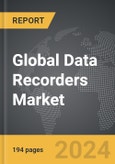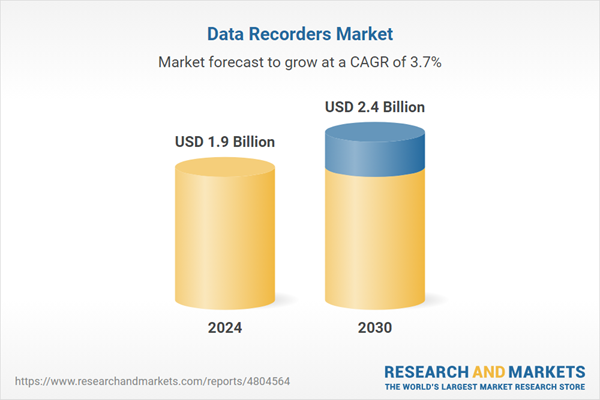The global market for Data Recorders was valued at US$1.9 Billion in 2024 and is projected to reach US$2.4 Billion by 2030, growing at a CAGR of 3.7% from 2024 to 2030. This comprehensive report provides an in-depth analysis of market trends, drivers, and forecasts, helping you make informed business decisions. The report includes the most recent global tariff developments and how they impact the Data Recorders market.
Segments: Type (Cockpit Voice Recorder, Flight Data Recorder, Quick Access Recorder, Voyage Data Recorder, Data Logger); Application (Aviation, Marine).
Geographic Regions/Countries: World; United States; Canada; Japan; China; Europe (France; Germany; Italy; United Kingdom; and Rest of Europe); Asia-Pacific; Rest of World.
The analysts continuously track trade developments worldwide, drawing insights from leading global economists and over 200 industry and policy institutions, including think tanks, trade organizations, and national economic advisory bodies. This intelligence is integrated into forecasting models to provide timely, data-driven analysis of emerging risks and opportunities.
Global Data Recorders Market - Key Trends and Drivers Summarized
What Are Data Recorders and How Do They Impact Critical Data Collection?
Data recorders, commonly known as black boxes in contexts like aviation and automotive, are devices designed to record vital operational data during the functioning of a vehicle or system. These devices are crucial for capturing a continuous stream of data inputs and outputs, including performance metrics, system status, and operational errors. The primary function of data recorders is to provide a factual and accurate record of events leading up to, during, and after operational incidents. This information is invaluable for troubleshooting, maintenance, and forensic analysis following an accident or failure, allowing organizations and regulatory bodies to understand what happened and why, and to implement measures to prevent future occurrences. The resilience and reliability of these devices under extreme conditions make them indispensable in fields requiring high safety and accuracy standards.How Are Modern Technologies Enhancing the Capabilities of Data Recorders?
The evolution of data recorders has been significantly influenced by advancements in sensor technology, data storage, and data analysis capabilities. Modern data recorders can capture a wide range of data types at high fidelity, from simple temperature and pressure readings to complex three-dimensional motion and high-definition audiovisual media. Integration with satellite and communications technology allows for real-time data transmission from virtually any location, enhancing the timeliness and relevance of the data collected. Furthermore, the incorporation of machine learning algorithms helps in predicting potential system failures before they occur, thereby not only providing a record of what happened but also offering a proactive tool to improve system safety and efficiency.What Challenges Are Involved in the Deployment and Operation of Data Recorders?
Deploying and operating data recorders involves several challenges, particularly concerning data privacy, storage, and management. In industries like healthcare or telecommunications, where sensitive data is routinely handled, ensuring the privacy and security of recorded data is paramount. The devices must be equipped with robust security features to prevent unauthorized access and data breaches. Additionally, the vast amounts of data generated by modern data recorders require substantial storage solutions, which must be both secure and accessible for analysis. Managing this data effectively demands sophisticated data management systems and protocols to ensure data integrity and usefulness over time. Moreover, the physical robustness of data recorders is a critical challenge in extreme environments, requiring advanced engineering to withstand conditions such as high impact, pressure, or temperature.What Drives the Growth in the Data Recorder Market?
The growth in the data recorder market is driven by several factors, reflecting the expanding scope and importance of data across various sectors. Increased safety regulations and standards across industries such as aviation, automotive, and maritime require thorough monitoring and recording of operational data, propelling the demand for advanced data recorders. Technological advancements that enhance the functionality and cost-effectiveness of data recorders also contribute to market growth. Additionally, the rising significance of data analytics in operational optimization and predictive maintenance is boosting the adoption of sophisticated data recording devices across manufacturing and processing industries. Consumer behavior that increasingly values safety, coupled with heightened regulatory and compliance requirements, continues to drive innovation and expansion in the data recorder market. These factors ensure a dynamic development trajectory for the deployment of data recorders in critical applications, emphasizing their pivotal role in modern data-driven operational frameworks.Report Scope
The report analyzes the Data Recorders market, presented in terms of units. The analysis covers the key segments and geographic regions outlined below.Segments: Type (Cockpit Voice Recorder, Flight Data Recorder, Quick Access Recorder, Voyage Data Recorder, Data Logger); Application (Aviation, Marine).
Geographic Regions/Countries: World; United States; Canada; Japan; China; Europe (France; Germany; Italy; United Kingdom; and Rest of Europe); Asia-Pacific; Rest of World.
Key Insights:
- Market Growth: Understand the significant growth trajectory of the Cockpit Voice Recorder segment, which is expected to reach US$1.1 Billion by 2030 with a CAGR of a 3.7%. The Flight Data Recorder segment is also set to grow at 4.0% CAGR over the analysis period.
- Regional Analysis: Gain insights into the U.S. market, valued at $512.5 Million in 2024, and China, forecasted to grow at an impressive 3.6% CAGR to reach $383.5 Million by 2030. Discover growth trends in other key regions, including Japan, Canada, Germany, and the Asia-Pacific.
Why You Should Buy This Report:
- Detailed Market Analysis: Access a thorough analysis of the Global Data Recorders Market, covering all major geographic regions and market segments.
- Competitive Insights: Get an overview of the competitive landscape, including the market presence of major players across different geographies.
- Future Trends and Drivers: Understand the key trends and drivers shaping the future of the Global Data Recorders Market.
- Actionable Insights: Benefit from actionable insights that can help you identify new revenue opportunities and make strategic business decisions.
Key Questions Answered:
- How is the Global Data Recorders Market expected to evolve by 2030?
- What are the main drivers and restraints affecting the market?
- Which market segments will grow the most over the forecast period?
- How will market shares for different regions and segments change by 2030?
- Who are the leading players in the market, and what are their prospects?
Report Features:
- Comprehensive Market Data: Independent analysis of annual sales and market forecasts in US$ Million from 2024 to 2030.
- In-Depth Regional Analysis: Detailed insights into key markets, including the U.S., China, Japan, Canada, Europe, Asia-Pacific, Latin America, Middle East, and Africa.
- Company Profiles: Coverage of players such as ACR Electronics, Inc., Captec Ltd., Consilium AB, Dac International, Inc., Danelec Marine A/S and more.
- Complimentary Updates: Receive free report updates for one year to keep you informed of the latest market developments.
Some of the 42 companies featured in this Data Recorders market report include:
- ACR Electronics, Inc.
- Captec Ltd.
- Consilium AB
- Dac International, Inc.
- Danelec Marine A/S
- FLYHT Aerospace Solutions Ltd.
- Honeywell International, Inc.
- Hr Smith Group
- L-3 Communications Holdings, Inc.
- Phoenix International Holdings, Inc.
- Raytheon Company
- Teledyne Technologies Inc.
- Telemar Norge AS
- Universal Avionics Systems Corporation
Tariff Impact Analysis: Key Insights for 2025
Global tariff negotiations across 180+ countries are reshaping supply chains, costs, and competitiveness. This report reflects the latest developments as of April 2025 and incorporates forward-looking insights into the market outlook.The analysts continuously track trade developments worldwide, drawing insights from leading global economists and over 200 industry and policy institutions, including think tanks, trade organizations, and national economic advisory bodies. This intelligence is integrated into forecasting models to provide timely, data-driven analysis of emerging risks and opportunities.
What’s Included in This Edition:
- Tariff-adjusted market forecasts by region and segment
- Analysis of cost and supply chain implications by sourcing and trade exposure
- Strategic insights into geographic shifts
Buyers receive a free July 2025 update with:
- Finalized tariff impacts and new trade agreement effects
- Updated projections reflecting global sourcing and cost shifts
- Expanded country-specific coverage across the industry
Table of Contents
I. METHODOLOGYII. EXECUTIVE SUMMARY2. FOCUS ON SELECT PLAYERSIII. MARKET ANALYSISIV. COMPETITION
1. MARKET OVERVIEW
3. MARKET TRENDS & DRIVERS
4. GLOBAL MARKET PERSPECTIVE
UNITED STATES
CANADA
JAPAN
CHINA
EUROPE
FRANCE
GERMANY
ITALY
UNITED KINGDOM
REST OF EUROPE
ASIA-PACIFIC
REST OF WORLD
Companies Mentioned (Partial List)
A selection of companies mentioned in this report includes, but is not limited to:
- ACR Electronics, Inc.
- Captec Ltd.
- Consilium AB
- Dac International, Inc.
- Danelec Marine A/S
- FLYHT Aerospace Solutions Ltd.
- Honeywell International, Inc.
- Hr Smith Group
- L-3 Communications Holdings, Inc.
- Phoenix International Holdings, Inc.
- Raytheon Company
- Teledyne Technologies Inc.
- Telemar Norge AS
- Universal Avionics Systems Corporation
Table Information
| Report Attribute | Details |
|---|---|
| No. of Pages | 194 |
| Published | April 2025 |
| Forecast Period | 2024 - 2030 |
| Estimated Market Value ( USD | $ 1.9 Billion |
| Forecasted Market Value ( USD | $ 2.4 Billion |
| Compound Annual Growth Rate | 3.7% |
| Regions Covered | Global |









